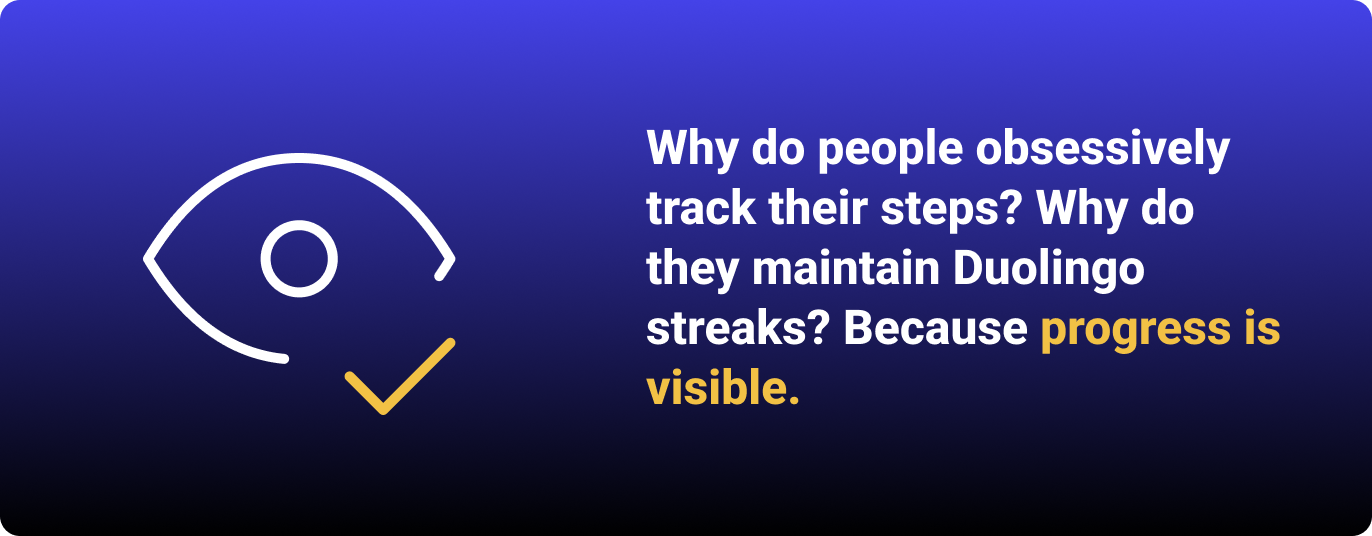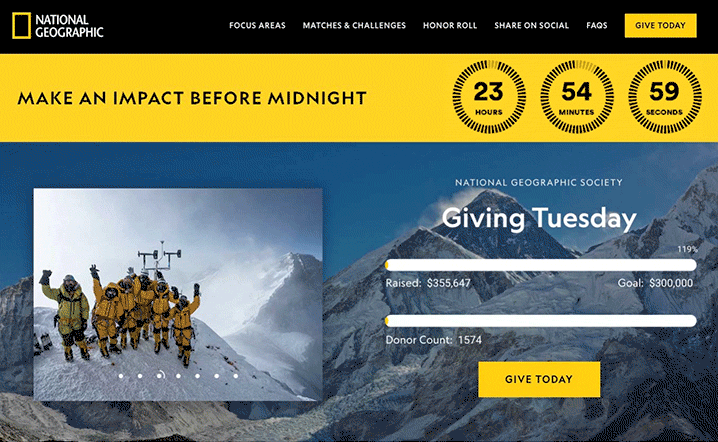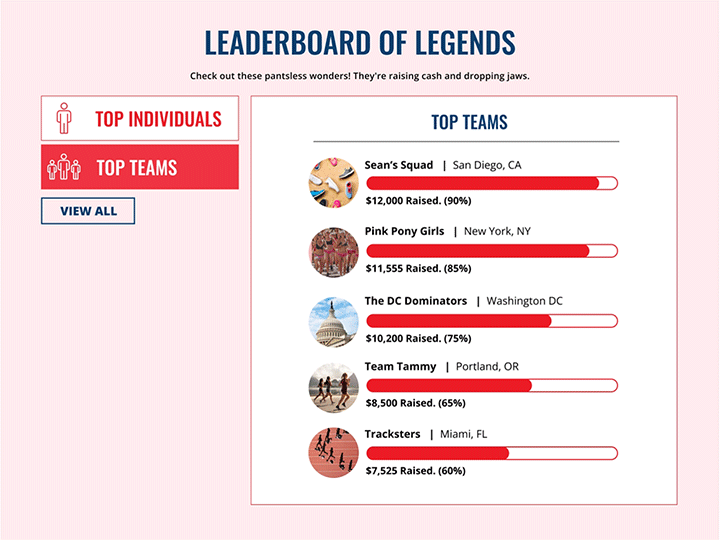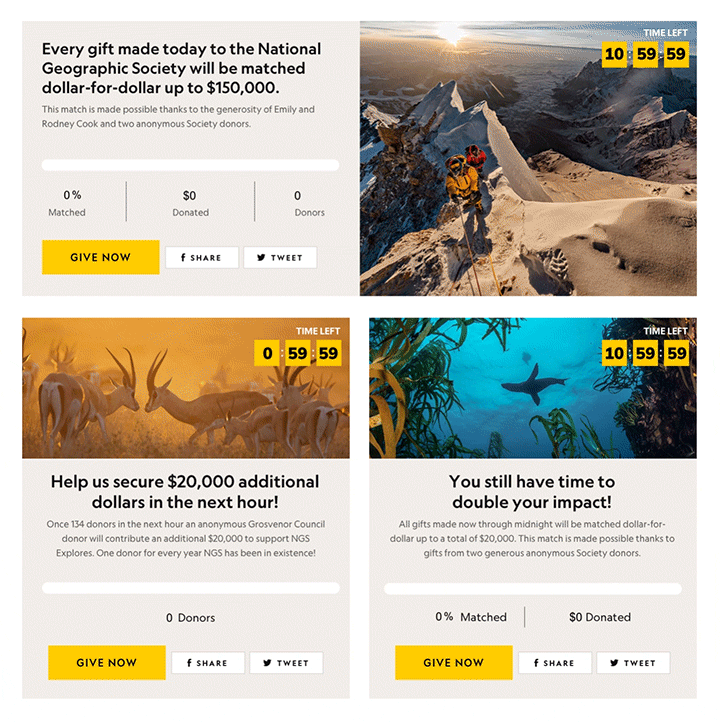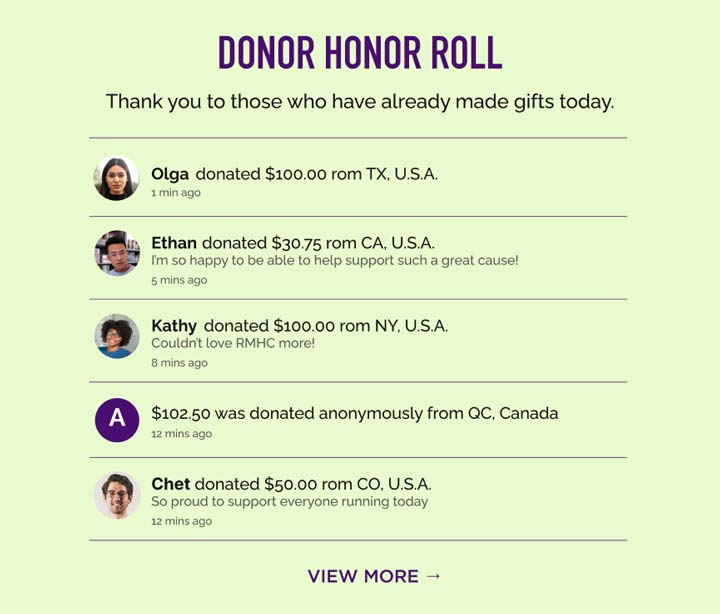Why Your Donors Give Once and Never Come Back
Your nonprofit has a problem, and it’s not about your mission. People care about what you do. They believe in your cause. They’re willing to give.
But they give once and disappear.
You send follow-up emails. You share impact stories. You launch new campaigns. And yet, most of your donors never give a second time. According to industry data, the average donor retention rate for nonprofits hovers around 45%—meaning you lose more than half your donors every single year.
Here’s the uncomfortable truth: fundraising has become a passive transaction in a world where people crave interaction, achievement, and recognition.
Think about it. Why do people obsessively track their steps on their phone? Why do they chase airline miles they’ll probably never use? Why do they maintain Duolingo streaks or Wordle scores? Because it feels rewarding. Because progress is visible. Because there’s a sense of accomplishment.
Your donation form asks for money and says “thank you.” That’s it. No progress. No achievement. No community. Just a transaction that feels… forgettable.
That’s where gamification comes in.
Gamification isn’t about turning fundraising into a video game. It’s about applying the psychological principles that make experiences engaging, habit-forming, and rewarding—and using them to create deeper connections between your supporters and your cause.
This isn’t a trend. Organizations using gamification see measurably different results: higher average gifts, better retention rates, more recurring donors, and supporters who actually come back for more. Some of our clients have seen donation increases of 47% when they implement strategic gamification.
This guide will show you exactly how to make it work for your organization—from the psychology behind why it works to specific features you can implement this month.
What Fundraising Gamification Actually Means
When most people hear “gamification,” they picture Mario coins and cartoon graphics. That’s not what we’re talking about.
Fundraising gamification is the strategic use of game mechanics—progress tracking, recognition, competition, rewards, achievement—to make giving more engaging, motivating, and habit-forming.
It’s taking elements that make games compelling and applying them to your fundraising experience:
- Progress bars that show donors how close you are to a goal
- Leaderboards that create friendly competition between fundraisers or schools
- Badges and achievements that recognize milestones
- Challenges that add urgency and excitement
- Rewards that incentivize specific actions
- Community features that make donors feel part of something bigger
The goal isn’t to make fundraising feel like a game. The goal is to make giving feel rewarding, visible, and meaningful—so donors want to do it again.
Why Gamification Works: The Psychology Behind It
Before we dive into tactics, let’s talk about why this actually works. Understanding the psychology helps you implement gamification strategically rather than just slapping badges on everything.
1. The Progress Principle
Humans are wired to complete things. When we see progress toward a goal—even someone else’s goal—we’re motivated to help finish it.
This is why crowdfunding campaigns that are 80% funded get exponentially more donations than campaigns at 20%. People want to be part of pushing something over the finish line.
A progress bar showing “$87,000 raised toward $100,000 goal” triggers something primal: “We’re so close. I can help finish this.” Without that visual progress, the same campaign feels abstract and endless.
Why it matters for your nonprofit: Showing progress—toward a dollar goal, toward a number of donors, toward an impact metric—makes donors feel like their contribution is part of a collective achievement, not just another drop in an infinite bucket.
2. Social Proof and Competition
We look to others to determine what’s normal and what’s worth doing. When we see that others are giving, we’re more likely to give. When we see that others are competing to give more, we want to join that competition.
Leaderboards tap into this powerfully. Seeing “Class of 2015 has raised $127K and leads the competition” does two things simultaneously: it shows that giving is happening (social proof) and it triggers competitive spirit (“Can our class beat that?”).
Even people who say they’re not competitive often respond to leaderboards—not because they want to win, but because they want to be recognized as contributors, not bystanders.
Why it matters for your nonprofit: Public recognition of giving—whether through leaderboards, donor walls, or real-time feeds—creates momentum. Early givers inspire later givers. Top fundraisers motivate others to try harder.
3. Achievement and Recognition
People crave acknowledgment. We want to be seen, appreciated, recognized for our contributions. This is why social media works. This is why people display diplomas and awards.
Traditional fundraising offers minimal recognition: your name on a donor list (maybe), a thank-you email (generic), and that’s it. Gamification offers layered recognition:
- First-time donor badge
- Recurring donor streak
- Top fundraiser status
- Social champion recognition
- Milestone achievements
Each of these feels earned. Each can be shared. Each reinforces identity: “I’m someone who supports this cause.”
Why it matters for your nonprofit: Recognition doesn’t cost you anything, but it creates emotional connection. Donors who feel recognized are far more likely to give again, give more, and tell others about your organization.
4. Loss Aversion and FOMO
We’re more motivated to avoid losing something than to gain something of equal value. This is why limited-time offers work. This is why countdown timers drive urgency.
In fundraising, this manifests as:
- “Only 3 hours left to unlock the matching gift!”
- “First 100 donors get a special badge”
- “Power hour—donations doubled for the next 60 minutes”
These aren’t manipulative tricks. They’re tactical urgency that respects people’s busy lives and gives them a reason to act now instead of “someday.”
Why it matters for your nonprofit: Most people who intend to donate eventually never actually do it. Urgency and scarcity create the activation energy needed to convert intention into action.
5. Autonomy and Mastery
People want to feel in control and see themselves improving. This is why fitness apps show progress over time. This is why language learning apps have levels.
In fundraising, this means:
- Letting donors set their own goals
- Showing their giving history over time
- Tracking their fundraising improvement
- Giving them tools to succeed (templates, resources, data)
When a fundraiser can see “Last year you raised $500, this year you’re at $750—you’re improving!”, that’s motivating in a way that generic encouragement isn’t.
Why it matters for your nonprofit: Donors who feel like they’re getting better at fundraising, or donors who can see their cumulative impact growing, develop an identity as “someone who does this successfully.” That identity drives retention.
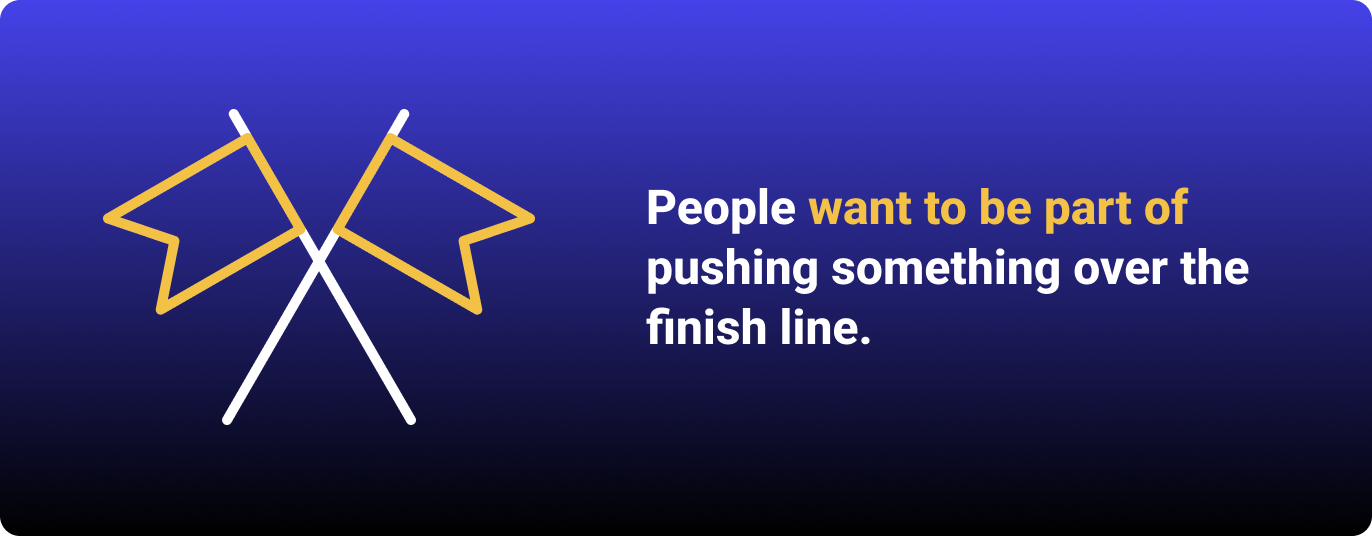 The Three Levels of Gamification (And Where You Should Start)
The Three Levels of Gamification (And Where You Should Start)
Not all gamification is created equal. There are three levels of sophistication, and where you start depends on your resources, timeline, and technical capabilities.
Level 1: Quick Wins (No Developer Required)
These are gamification tactics you can implement immediately using tools you already have. They’re not technically sophisticated, but they work.
Progress bars using your fundraising platform’s built-in goal tracker. Most platforms (including GoFundMe Pro) show a thermometer or progress bar. Make sure it’s prominent on your campaign page and update your goal strategically—hitting 100% and then setting a stretch goal creates multiple moments of achievement.
Recognition in emails and social media. Call out first-time donors, recurring givers, or top fundraisers publicly. A simple “Shout-out to Maria who just made her 6th monthly gift!” costs nothing and makes Maria feel seen. Tag people when appropriate to encourage shares.
Simple leaderboards using graphics. Create a Canva graphic listing your top 10 fundraisers or top 5 teams. Share it in emails, on your website, and on social media. Update it weekly during a campaign. People will check to see if they’re on it—and those who aren’t might push harder to make the list.
Limited-time challenges via email or social. “If we get 50 donors by midnight, a generous supporter will unlock an extra $5K!” This adds urgency without changing your website. Announce it, track it publicly, celebrate when you hit it.
Donor recognition walls on a blog post or dedicated page. List recent donors (with permission), organized by giving level or recency. This is easy to maintain and provides public acknowledgment.
Social sharing incentives. Ask donors to share their support online and offer a small reward—an exclusive update, a digital thank-you card, or a “Social Champion” badge. Track who does it and recognize them.
These tactics require minimal investment but begin to shift fundraising from transactional to experiential.
Level 2: Strategic Gamification (Some Technical Integration)
This is where you’re adding real gamification features to your website, not just working around the edges. This typically requires website development or integration work but doesn’t need a complete custom build.
Real-time progress bars on your website that update automatically as donations come in. Not just showing a static goal, but pulling live data from your fundraising platform and displaying it prominently. During a Giving Day, seeing the total climb every time you refresh is incredibly motivating.
Dynamic leaderboards that update throughout a campaign. Whether it’s individual fundraisers, teams, schools, or corporate partners—live rankings create ongoing competition and give people a reason to check back frequently.
Milestone-based badges and achievements. When someone hits their fundraising goal, they automatically receive a “Goal Crusher” badge. When someone makes their fifth donation, they get a “Loyal Supporter” badge. These can display on their profile, in emails, or be shareable on social media.
Fundraising challenges with time limits. Create mini-challenges within your main campaign: “Raise $100 between 2-3pm today for a bonus raffle entry” or “Log 50 miles this week to earn an exclusive badge.” These create multiple moments of urgency and achievement rather than one long campaign.
Recurring giving streaks. Track and celebrate consecutive monthly gifts. “Maria, you’re on a 14-month giving streak—keep it going!” Visualizing streaks makes people not want to break them (hello, Duolingo psychology).
Social sharing trackers. Show donors how many times they’ve shared your campaign and reward high sharers with recognition or perks. Tracking makes the behavior visible and therefore more likely to repeat.
This level requires investment in your website and integration with your fundraising platform, but it creates significantly more engagement than Level 1 tactics alone.
Level 3: Advanced Gamification Ecosystem (Custom Development)
This is where fundraising becomes a fully gamified experience with personalized dashboards, complex logic, and sophisticated community features. This is what we build for clients running major campaigns.
Personalized fundraising portals where each participant has their own dashboard showing their fundraising progress, activity tracking (if relevant), resources, earned rewards, and next milestones. Everything they need in one branded space.
Team-based competitions with captain dashboards. Team captains can see each member’s progress, send encouragement, track collective totals, and compete against other teams. Captains become volunteer campaign managers.
Complex incentive systems with multiple variables. For example: “Log 150 minutes of activity + raise $100 = 1 raffle ticket. Each additional $100 = another ticket (max 10).” The system calculates this automatically and shows participants exactly where they stand.
Interactive maps showing donations by geography in real-time. Watch your city, state, or country light up as people give. During multi-city events, show which location is leading.
Ambassador portals for non-fundraising supporters. Track how many people they’ve recruited, how many times they’ve shared, and reward them accordingly. Different from fundraiser portals because the metrics are about reach, not dollars.
Real-time donor feeds displaying recent gifts as they come in. “Sarah just donated $50!” Creates momentum and shows activity is happening right now.
Achievement systems that unlock content or experiences. Reach certain milestones to see exclusive videos, get early access to events, or unlock behind-the-scenes updates.
This level is where gamification moves from “nice feature” to “core campaign infrastructure.” It’s what organizations running sophisticated peer-to-peer campaigns, university giving days, or multi-city events need to manage at scale.
The Core Gamification Features (And When to Use Each)
Let’s break down the specific gamification mechanics and when each makes sense for your campaigns.
Progress Bars: The Foundation
What they are: Visual representations of progress toward a goal—typically a thermometer, bar, or circle that fills as you get closer to a target.
Why they work: Humans are completion-driven. Seeing 85% progress triggers “we’re so close!” motivation. Studies show campaigns that are 75%+ funded see exponentially more donations than those under 50%.
When to use them:
- Every campaign should have at least one progress bar showing total toward goal
- Giving Days benefit from multiple progress bars (overall goal, hourly goals, school vs school)
- Peer-to-peer campaigns should show individual fundraiser progress and team progress
- Multi-location events can show location-specific and national progress
Pro tip: Set achievable initial goals so you hit 100% and can announce a stretch goal. Multiple moments of achievement are better than one distant target.
Leaderboards: Harnessing Competition
What they are: Rankings showing top performers—individual fundraisers, teams, schools, corporate partners, regions, etc.
Why they work: Social proof (others are giving!) + competition (can we beat them?) + recognition (we want to be on that list). Even non-competitive people respond to leaderboards because they don’t want to feel left out.
When to use them:
- University giving days: school vs. school, class year competitions
- Corporate challenges: company vs. company, department vs. department
- Peer-to-peer campaigns: individual fundraiser rankings, team rankings
- Multi-city events: city vs. city competitions
- Giving Tuesday: organization vs. organization (if coordinating with others)
Different types of leaderboards:
- Total dollars raised: The classic. Shows who’s raising the most money.
- Number of donors: Rewards those who activate their network, not just wealthy donors.
- Participation rate: For organizations/teams, shows percentage of members who gave (levels playing field).
- Per-capita fundraising: Average raised per person (helps smaller groups compete).
- Activity-based: For campaigns tracking miles, minutes, or actions—ranks by non-monetary metrics.
Pro tip: Use multiple leaderboards so different groups can win in different categories. A small team with 100% participation can be celebrated even if a larger team raised more total dollars.
Badges and Achievements: Recognition That Sticks
What they are: Digital awards given for hitting specific milestones or completing certain actions.
Why they work: They create moments of celebration, provide shareable recognition, and build identity (“I’m someone who earned the Goal Crusher badge”).
Common badge types:
Fundraising milestones:
- First donation made
- Fundraising goal hit
- Raised over $500/$1,000/$5,000
- Top 10 fundraiser
Behavioral achievements:
- Early bird (donated in first hour)
- Social champion (shared 10+ times)
- Team builder (recruited 5+ fundraisers)
- Loyal supporter (5+ consecutive months)
Activity-based (for campaigns tracking actions):
- 100 miles logged
- 300 minutes completed
- 50 actions taken
Engagement milestones:
- Created a fundraising page
- Joined a team
- Attended a webinar
- Completed training
Pro tip: Make badges visually appealing and shareable. People will post “I just earned my Top Fundraiser badge for @YourNonprofit!” on social media if the badge looks good. Free marketing.
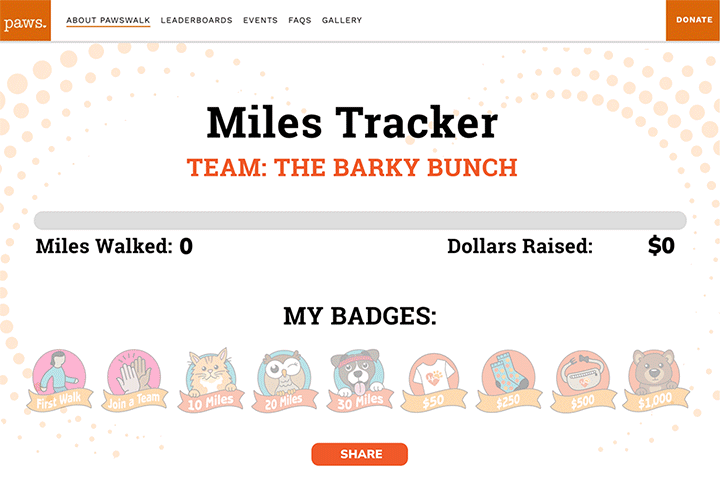 Challenges: Creating Urgency and Excitement
Challenges: Creating Urgency and Excitement
What they are: Time-bound goals or competitions that create focused bursts of activity.
Why they work: Urgency compresses decision-making (“I need to act NOW, not someday”). Challenges also create multiple peaks of excitement rather than one long slog.
Types of challenges:
Time-based:
- Power hours: “Donations doubled 2-3pm today”
- Flash challenges: “First 50 donors get a bonus badge”
- Daily goals: “Let’s hit 100 donors today”
- Countdown challenges: “48 hours left to unlock matching funds”
Milestone-based:
- “If we reach 500 donors, a supporter will donate an extra $10K”
- “First team to $5K wins a pizza party”
- “Hit your personal goal by Friday for bonus raffle entry”
Competitive:
- “Can Engineering beat Medicine’s total from last year?”
- “Department challenge: which team can get 100% participation?”
- “City challenge: Dallas vs. Houston—who raises more?”
Pro tip: Announce challenges throughout your campaign, not just at the start. Keep giving people new reasons to engage, check back, and take action.
Rewards and Incentives: Making Action Tangible
What they are: Physical or digital rewards given for hitting milestones or completing actions.
Why they work: They make abstract achievement concrete. “I did X, I got Y” is satisfying in a way that “I contributed to collective good” (while true) is not.
Types of rewards:
Physical rewards (traditional):
- T-shirts, water bottles, hoodies based on fundraising tiers
- Event tickets or VIP experiences
- Branded swag (stickers, pins, tote bags)
Digital rewards (modern, scalable):
- Exclusive content unlocks (behind-the-scenes videos, early announcements)
- Virtual badges and certificates (shareable, collectable)
- Recognition in special email or video thank-you
- Access to donor-only webinars or Q&As
Experience-based rewards:
- Meet the team/beneficiaries events
- Behind-the-scenes tours
- Input on programming decisions
- Name recognition (on a wall, in a space, in materials)
Raffle/contest entries:
- Particularly popular for campaigns combining activity + fundraising
- “150 minutes + $100 = 1 raffle ticket”
- Multiple ways to earn entries keeps people engaged
Pro tip: Digital rewards scale better than physical ones and can be delivered instantly. The moment someone hits a milestone, they get their reward—instant gratification is powerful.
Donor Walls and Recognition Feeds: Public Acknowledgment
What they are: Public displays of who’s giving, how much (or just that they gave), and sometimes why.
Why they work: Public recognition satisfies our need to be seen and appreciated. It also provides social proof that encourages others to give.
Types:
Static donor walls:
- Names listed by giving level on website or physical space
- Updated periodically (monthly, quarterly, annually)
- Traditional but still effective
Real-time donation feeds:
- “Sarah just donated $50!” appearing on your website as gifts come in
- Creates momentum and urgency
- Shows activity is happening right now
Donor maps:
- Geographic visualization of where support is coming from
- Particularly powerful for campaigns with regional competition
- “Look at all these pins—we’re everywhere!”
Social media shout-outs:
- Tagging donors (with permission) in thank-you posts
- Resharing their posts about why they gave
- Highlighting milestones (“Maria just made her 10th gift!”)
Pro tip: Always respect donor privacy preferences. Anonymous gifts should be included in totals but excluded from public recognition. Donor names display only when they’ve given explicit permission.
Gamification Strategies by Campaign Type
Different campaigns benefit from different gamification approaches. Here’s what works for each major campaign type:
University Giving Days
Primary mechanics: School vs. school leaderboards, class year competitions, alumni participation tracking, matching gift challenges, power hours
Why it works: Alumni identity is strong. People care about their school beating rival schools, their class year outperforming others, and being part of university-wide success.
Key features:
- Main leaderboard: which school has raised the most
- Secondary leaderboard: which class year has the most donors
- Participation percentage rankings (small classes can compete)
- Real-time total climbing throughout 24 hours
- Hourly mini-challenges to create multiple peaks
Example: Columbia University raised $2.3M in 24 hours using school-based leaderboards that updated every 1-2 minutes, creating constant checking and competitive giving throughout the day.
Run/Walk/Ride Events
Primary mechanics: Activity tracking + fundraising integration, team competitions, milestone achievements, personal bests, geographic competition
Why it works: Participants are motivated by both personal fitness goals AND fundraising goals. Combining them creates dual motivation.
Key features:
- Fundraising progress bars for individuals and teams
- Activity logging (miles walked/run, minutes exercised, steps taken)
- Combined milestones: “100 miles logged + $500 raised = finisher medal”
- Team leaderboards by location or category
- Personal records: “You’ve logged more miles than last year!”
Example: Texas Children’s Mindful Minutes tracked both mindfulness activities (meditation, yoga) and fundraising with raffle tickets earned for hitting combined milestones (150 minutes + $100 raised).
Corporate Workplace Giving
Primary mechanics: Company vs. company leaderboards, department competitions, employee participation tracking, matching gift unlocks, executive challenges
Why it works: Workplace identity and department pride drive competition. Companies want recognition. Employees respond to challenges from colleagues and leadership.
Key features:
- Company leaderboards (total raised)
- Per-capita leaderboards (average per employee—levels playing field)
- Participation rate rankings (percentage of employees giving)
- Department vs. department competitions within companies
- Executive matches: “If we hit 50% participation, CEO matches up to $10K”
Example: Home Depot employees raising funds through a portal where they could see department rankings, individual progress, and company-wide totals—all competing while supporting the cause.
Giving Tuesday / Day of Giving
Primary mechanics: Countdown timers, flash challenges, matching gift unlocks, hourly goals, real-time updates, participation leaderboards
Why it works: 24-hour urgency compressed into one intense day requires constant engagement cues, multiple peaks of activity, and visible momentum.
Key features:
- Countdown clock to start and end of event
- Real-time totals updating frequently
- Hourly power hours: “Donations doubled this hour!”
- Flash challenges: “First 100 donors get bonus badge”
- Multiple matching gift unlocks throughout day
- Early bird incentives for first wave of donors
Pro tip: Don’t make people wait until the end to know results. Show progress constantly. Every hour should feel like a mini-campaign with its own goal and recognition.
Peer-to-Peer Campaigns (General)
Primary mechanics: Individual fundraiser dashboards, team captain tools, fundraiser leaderboards, resource hubs, social sharing tracking, recruiter recognition
Why it works: Fundraisers need tools, motivation, and recognition to succeed. Making it easy and rewarding increases their effort and results.
Key features:
- Personal dashboard showing their progress toward goal
- Resources: email templates, social graphics, talking points
- Fundraiser leaderboard (can we make top 10?)
- Team leaderboards (if organized by teams)
- Social champion recognition for those who share frequently
- Recruiter rewards for bringing in new fundraisers
Example: Any campaign where individuals create their own fundraising pages benefits from portals that give fundraisers visibility into their progress, tools to succeed, and recognition for their efforts.
Ambassador Programs
Different use case: Ambassador programs aren’t primarily about fundraising—they’re about recruitment, promotion, and network activation.
Primary mechanics: Recruitment tracking, share counting, referral rewards, influence metrics, exclusive access
Why it works: Ambassadors are motivated by impact (how many people I brought in) and recognition (being seen as a champion for the cause).
Key features:
- Track how many people signed up using ambassador’s unique link
- Count shares on social media
- Show which shares drove the most traffic/signups
- Leaderboards based on recruitment, not money
- Exclusive access to events or content for top ambassadors
Pro tip: Ambassador portals are fundamentally different from fundraiser portals because the metrics and incentives are different. Don’t try to make ambassadors into fundraisers—celebrate them for what they actually do.
How to Implement Gamification Without Overwhelming Donors
One of the biggest concerns we hear: “Won’t this feel gimmicky? Won’t it distract from our mission?”
The answer: only if you do it badly.
The Principles of Good Gamification
- Always Connect Back to Mission
Every gamified element should reinforce why the cause matters, not distract from it.
Bad: “Earn points for clicking buttons!”
Good: “Earn badges for actions that spread awareness—each share reaches 10 more people who might help.”
Bad: “Win the competition!”
Good: “When Engineering and Medicine compete, more students get scholarships. Everyone wins.”
The competition or game mechanic is the vehicle. Impact is the destination. Never lose sight of that.
- Make It Optional, Not Mandatory
Not everyone responds to gamification the same way. Some donors love leaderboards. Others find them off-putting. Give people ways to engage without forcing participation in competitive elements.
How to do this:
- Make leaderboards visible but not the only way to see progress
- Let people opt out of public recognition if they prefer privacy
- Provide multiple paths to engagement (some competitive, some not)
- Never make someone feel bad for not participating in challenges
- Keep It Simple
The best gamification feels intuitive, not complicated. If you need a page of instructions to explain how your points system works, you’ve overcomplicated it.
Simple: “Raise $500, get a t-shirt”
Too complex: “Earn XP points based on a formula (dollars × 0.5 + shares × 10 + referrals × 25) and redeem them in our rewards marketplace where items cost varying amounts of points depending on…”
You get the idea. Simple wins.
- Prioritize Transparency
If there are rules, make them crystal clear. If there are milestones, show exactly where people stand. If there are rewards, explain exactly how to earn them.
Confusion kills motivation. Clarity drives action.
- Celebrate Publicly, Fail Privately
Recognize achievements publicly. Leaderboards, badges, shout-outs—these should be visible and celebrated.
But never shame someone for not participating or not hitting goals. Don’t show “bottom 10 fundraisers” lists. Don’t call out people who haven’t donated yet. Positive reinforcement only.
Common Mistakes (And How to Avoid Them)
We’ve seen organizations implement gamification in ways that backfire. Learn from their mistakes:
Mistake #1: Too Many Mechanics at Once
The problem: You get excited about gamification and launch leaderboards + badges + challenges + rewards + points + levels all at once. Users are overwhelmed and don’t engage with any of it effectively.
The fix: Start with 2-3 core mechanics. Maybe a leaderboard + progress bars + milestone badges. Get those working well, get people using them, then add more later.
Mistake #2: Unclear or Changing Rules
The problem: You launch a challenge but don’t explain how to earn rewards. Or you change the rules mid-campaign. People get confused and frustrated.
The fix: Write down all rules before launch. Make them visible and accessible. If you must change something mid-campaign, communicate it clearly and explain why.
Mistake #3: Neglecting the Non-Competitive
The problem: You make everything about winning and being #1. People who aren’t top performers feel discouraged and drop out.
The fix: Create multiple ways to win. Top fundraiser leaderboards for the competitive folks, AND participation badges for everyone who shows up, AND milestone achievements anyone can hit, AND team-based competitions where collective effort matters.
Mistake #4: Rewards That Don’t Arrive
The problem: You promise rewards for hitting milestones but then don’t deliver them promptly (or at all). Trust is broken.
The fix: Only promise rewards you can actually fulfill. Digital rewards are easier to deliver instantly than physical ones. If offering physical rewards, set clear expectations about timing and have a fulfillment plan in place before launch.
Mistake #5: Forgetting About Mobile
The problem: Your gamification looks great on desktop but is clunky or non-functional on phones. Most people check campaign progress on mobile.
The fix: Mobile-first design. Test everything on actual phones. Progress bars, leaderboards, dashboards—all need to work seamlessly on small screens.
Mistake #6: Data That Doesn’t Update
The problem: You show “real-time” data that’s actually hours old. People check, see nothing’s changed, stop checking.
The fix: Set accurate expectations. If data updates every 5 minutes, say so. If it’s truly live, make sure it actually is. Show “last updated” timestamps. Don’t promise real-time if you can’t deliver near-real-time.
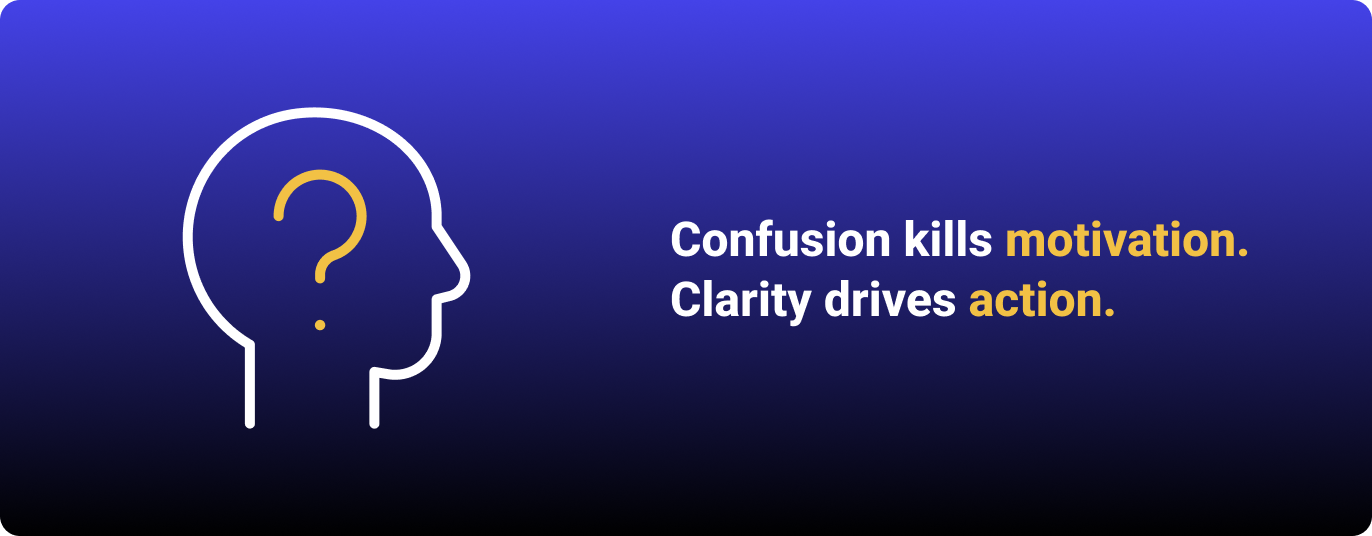
The Technical Side: What You Actually Need
Let’s talk about what’s required technically to implement different levels of gamification.
For Level 1 (Quick Wins):
Required:
- Access to your fundraising platform’s dashboard (to pull numbers)
- Email platform or social media accounts (for recognition)
- Basic graphic design tools (Canva works fine)
- Spreadsheet for tracking (if needed)
Time investment: A few hours per week to update manually
Cost: Essentially free (using tools you already have)
For Level 2 (Strategic Gamification):
Required:
- Website with ability to add custom features
- Integration with your fundraising platform’s API
- Developer or agency to build integrations
- Badge/achievement system (can be simple)
Time investment: 4-6 weeks initial build, then minimal ongoing maintenance
Cost: $10K-25K for professional integration (one-time), plus potential ongoing hosting/support fees
What you get: Automated updates, live data displays, badge systems that work without manual intervention
For Level 3 (Advanced Ecosystem):
Required:
- Custom portal development on your domain
- Full API integration with fundraising platform
- Database for tracking activities, achievements, rewards
- Admin dashboard for your team
- Participant-facing dashboards
- Sophisticated logic for complex incentives
Time investment: 12-16 weeks initial build, ongoing optimization
Cost: $75K+ for comprehensive custom portal solutions
What you get: Fully automated gamification ecosystem where participants have personalized experiences, admins have complete visibility and control, and complex campaigns can be managed at scale without manual intervention
Measuring Success: What to Track
You can’t improve what you don’t measure. Here are the key metrics to track when implementing gamification:
Engagement Metrics
- Return visits to campaign page: Are people checking back more frequently?
- Time on site: Are visitors spending more time exploring?
- Page views per session: Are they viewing multiple pages?
- Social shares: How often is content being shared?
Fundraising Metrics
- Average gift size: Has it increased with gamification?
- Conversion rate: What percentage of visitors donate?
- Number of donors: Total donor count
- Recurring gift rate: How many donors set up monthly giving?
Participation Metrics
- Fundraiser sign-up rate: For peer-to-peer campaigns
- Fundraiser completion rate: How many hit their goals?
- Team formation: How many teams are created?
- Activity logging: For campaigns tracking non-monetary actions
Gamification-Specific Metrics
- Badge distribution: How many badges earned total? Which types?
- Leaderboard engagement: How many people check leaderboards?
- Challenge participation: What percentage engage with challenges?
- Achievement rate: What percentage of users hit milestones?
Compare Year Over Year
The most important comparison is: How does this campaign with gamification compare to the same campaign last year without it (or with less of it)?
Look at:
- Total raised
- Number of donors
- Average gift
- Retention rate
- Engagement metrics
If you see 20-50% improvements, gamification is working.
Real Results: What Organizations Actually See
Let’s talk about actual outcomes, not hypotheticals.
Organizations we’ve worked with that implement strategic gamification typically see:
Donor engagement: 30-50% increase in repeat visits to campaign pages during active campaigns. People check back more frequently when there are leaderboards to watch and progress to track.
Average gift size: 15-25% increase in average donation amount. Seeing others give larger amounts + competitive element + visible impact = higher gifts.
Fundraiser performance: In peer-to-peer campaigns, fundraisers with access to gamified portals (showing their progress, resources, leaderboards) raise 40-60% more on average than those without.
Donor retention: 20-30% improvement in retention rates when gamification includes recognition, streaks, and recurring giving challenges.
Social sharing: 3-5x more social media sharing when share tracking and social champion recognition are implemented.
Campaign growth: Year-over-year growth of 30-100% when sophisticated gamification is added to previously non-gamified campaigns.
One specific example: A university giving day that added school-vs-school leaderboards and hourly challenges saw a 3x increase in total raised compared to the previous year without gamification.
Texas Children’s Hospital implemented a custom portal for their Mindful Minutes campaign that combined activity tracking (meditation, yoga, mindfulness minutes) with fundraising. The gamified system included:
- Raffle ticket logic: 150 minutes + $100 raised = 1 ticket (each additional $100 = another ticket)
- Personal dashboards showing both activity and fundraising progress
- Team captain tools for managing groups
- Resource hubs with templates and guides
The result? Participants were far more engaged than previous campaigns, fundraising goals were exceeded, and the organization had clean data on both activities completed and funds raised.
City of Hope’s Walk for Hope uses sophisticated portal technology to manage thousands of participants across multiple locations. Their gamified system includes:
- Real-time leaderboards by location and team
- Activity tracking integrated with fundraising
- Captain dashboards for team management
- Donor recognition at multiple levels
- Progress visualization that updates throughout the campaign
These aren’t hypothetical examples. These are real campaigns we’ve built, and the results speak for themselves.
Getting Started: Your Gamification Roadmap
So you’re convinced gamification can work for your nonprofit. Now what?
Here’s your step-by-step roadmap to implementing gamification effectively:
Step 1: Define Your Goals (Week 1)
Before you add a single progress bar, get crystal clear on what you’re trying to achieve.
Ask yourself:
- What’s the primary problem we’re solving? (Low retention? Small average gifts? Lack of engagement?)
- What would success look like? (30% increase in recurring donors? 50% more peer-to-peer fundraisers?)
- Which campaigns would benefit most from gamification?
- What metrics will we track to measure success?
Write these down. They’ll guide every decision you make about which gamification features to implement.
Step 2: Know Your Audience (Week 1-2)
Different audiences respond to different gamification mechanics.
Consider:
- Who are your primary donors? (Age, tech-savviness, motivations)
- What currently motivates them to give?
- Are they competitive or collaborative by nature?
- What social platforms do they use?
- What’s worked in past campaigns?
If your donors are competitive alumni who love their school, leaderboards will crush it. If they’re collaborative community members who care about collective impact, focus on shared goals and community achievements.
Step 3: Start with Level 1 Quick Wins (Week 2-4)
Don’t try to build a custom portal on day one. Start with tactics that require minimal investment:
- Add progress bars to your current fundraising pages
- Recognize top donors publicly via email and social media
- Create a simple leaderboard graphic and share it weekly
- Launch one time-limited challenge during your next campaign
Test these. See what resonates. Measure the results. This gives you data to justify bigger investments later.
Step 4: Measure and Learn (Ongoing)
Track everything:
- Which tactics drove the most engagement?
- Did average gift size increase?
- Did donors return more frequently?
- What did donors say about the experience?
Use this data to refine your approach. Maybe leaderboards worked great but badges didn’t resonate. Maybe challenges drove urgency but rewards felt gimmicky. Listen to the data and iterate.
Step 5: Invest in Strategic Integration (Month 3-6)
Once you’ve proven gamification works with quick wins, it’s time to integrate it properly into your website.
Budget for:
- Developer time to build integrations with your fundraising platform
- Design work to make gamification elements visually appealing
- Testing and quality assurance
- Training for your team
This is where you move from manual updates to automated systems. Progress bars that update in real-time. Leaderboards that refresh automatically. Badges that are awarded without manual intervention.
Expected investment: $10K-25K depending on complexity and features.
Step 6: Consider Advanced Solutions for Major Campaigns (Month 6-12)
If you’re running sophisticated peer-to-peer campaigns, university giving days, multi-city events, or programs where you’re managing hundreds (or thousands) of participants, Level 3 solutions make sense.
This is where you build:
- Custom fundraising portals with personalized dashboards
- Team captain tools and management systems
- Complex incentive logic that calculates automatically
- Ambassador portals for non-fundraising supporters
- Admin dashboards with real-time reporting
Expected investment: $75K+ for comprehensive custom solutions.
This isn’t for every organization. But for those running campaigns at scale, the ROI justifies the investment. When a custom portal helps you raise an extra $500K on a campaign that was already raising $2M, the $75K investment pays for itself many times over.
Common Questions About Gamification
Let’s address the questions we hear most often:
“Won’t gamification feel gimmicky?”
Only if you do it badly. When gamification is tied directly to mission impact, it feels purposeful, not gimmicky.
Gimmicky: “Click this button 100 times to unlock points!”
Purposeful: “When we reach $50K, we can fund an entire scholarship. We’re at $47K—help us finish!”
The difference is that purposeful gamification always connects back to real impact. The game mechanics are the vehicle, not the destination.
“What if competitive elements turn off some donors?”
That’s why you offer multiple paths to engagement. Leaderboards for the competitive folks. Milestone achievements for those who prefer personal goals. Team challenges for the collaborative. Public recognition for some, private badges for others.
Give people choices about how they engage, and you’ll appeal to a broader range of donor personalities.
“How do we get organizational buy-in?”
Start with data. Show leadership examples of organizations similar to yours that have seen measurable results from gamification. Then start small with Level 1 quick wins that require minimal investment. When you can show a 20% increase in donations from a simple progress bar, it’s easier to get budget for bigger projects.
“What if we don’t have the budget for custom development?”
Then start with Level 1 and Level 2 tactics. You can see significant results without custom portals. Many nonprofits successfully use progress bars, leaderboards, and recognition strategies without spending a dollar on development.
Save up for bigger investments by showing results from smaller implementations first.
“How do we handle donor privacy with public leaderboards?”
Always respect donor preferences. Include clear opt-in/opt-out language in your donation forms. Anonymous gifts should be included in totals but excluded from public recognition. Make it easy for donors to choose whether they want their name displayed publicly.
“What if our fundraising platform doesn’t have an API?”
This limits what you can do with real-time data, but doesn’t eliminate gamification entirely. You can still manually update leaderboards, recognize donors publicly, create challenges, and offer rewards. It’s more labor-intensive, but it works.
If you’re serious about gamification long-term, consider this when evaluating or switching fundraising platforms.
Your Next Steps
You’ve made it through this entire guide. You understand the psychology, you know the tactics, you’ve seen the results, and you have a roadmap.
Now it’s time to act.
This week:
- Identify one campaign where gamification would make sense
- Choose 2-3 Level 1 tactics you can implement immediately
- Define what success looks like and how you’ll measure it
This month:
- Implement those quick wins
- Track the results
- Get feedback from your team and donors
This quarter:
- Evaluate whether Level 2 strategic integration makes sense
- If yes, get quotes from developers or agencies
- Plan your next major campaign with gamification built in from the start
This year:
- If you’re running campaigns at scale, evaluate whether Level 3 custom solutions would provide ROI
- Build a business case based on your data from earlier implementations
- Consider gamification not as a one-time project but as an ongoing strategy
Let’s Make Fundraising Engaging Again
Fundraising doesn’t have to be boring. Giving doesn’t have to feel transactional. Your supporters don’t have to disappear after one donation.
Gamification transforms fundraising from something people do once and forget into an experience they want to return to, share with friends, and be part of long-term.
The nonprofits that embrace this now will have a massive advantage. While others are still sending generic donation requests and wondering why retention is low, you’ll be building a community of engaged supporters who give more, give more often, and bring others along with them.
Your mission deserves that kind of support.
Ready to gamify your fundraising?
If you’re running peer-to-peer campaigns, university giving days, or events where you need sophisticated gamification at scale, Mittun specializes in building custom fundraising portals and gamified experiences that drive real results.
We’ve built portals for organizations like City of Hope, Texas Children’s Hospital, and Columbia University—campaigns that have raised millions using the exact strategies outlined in this guide.
Book a strategy session to explore how gamification could transform your fundraising.
This guide is based on Mittun’s experience building 1,000+ nonprofit websites and custom fundraising solutions for organizations raising millions annually. For more insights on nonprofit technology, fundraising strategy, and donor engagement, explore our blog.

